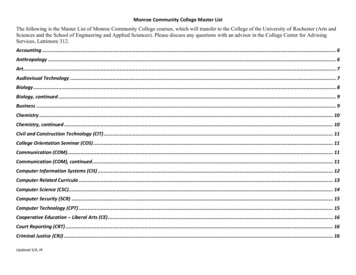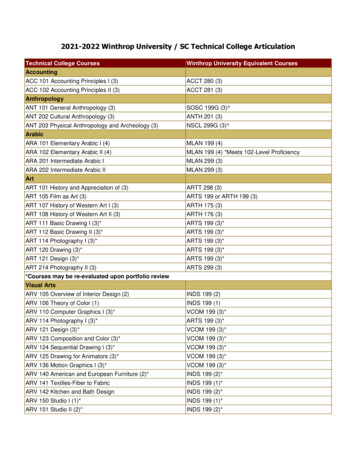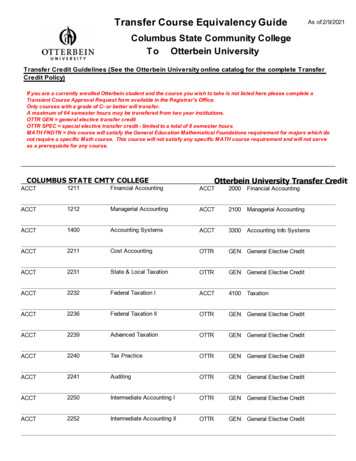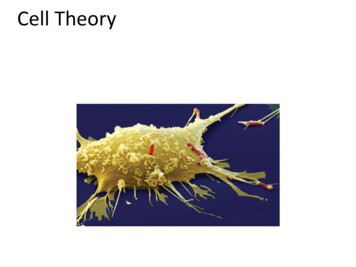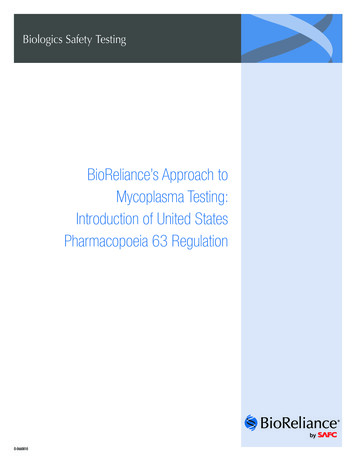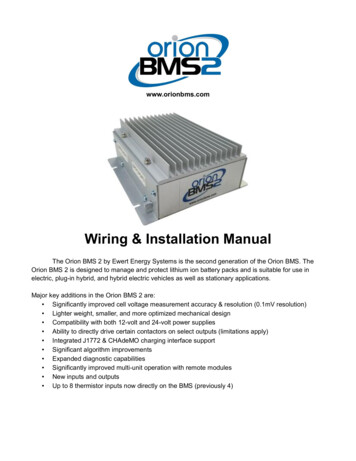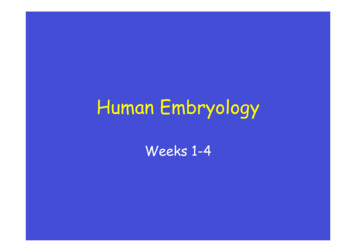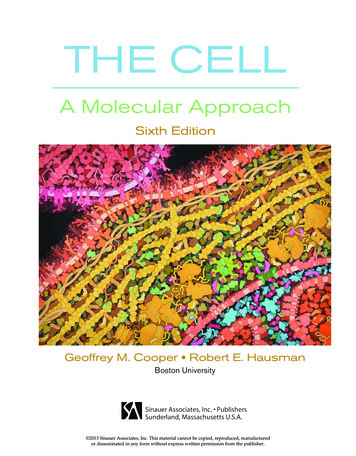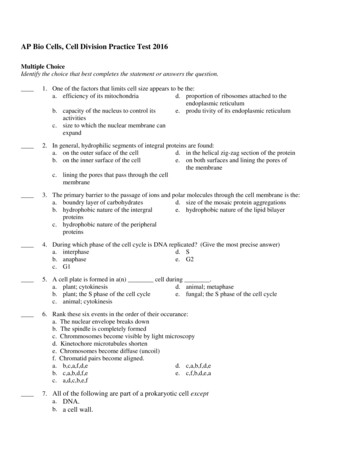
Transcription
AP Bio Cells, Cell Division Practice Test 2016Multiple ChoiceIdentify the choice that best completes the statement or answers the question.1. One of the factors that limits cell size appears to be the:a. efficiency of its mitochondriad. proportion of ribosomes attached to theendoplasmic reticulumb. capacity of the nucleus to control itse. produ tivity of its endoplasmic reticulumactivitiesc. size to which the nuclear membrane canexpand2. In general, hydrophilic segments of integral proteins are found:a. on the outer suface of the celld. in the helical zig-zag section of the proteinb. on the inner surface of the celle. on both surfaces and lining the pores ofthe membranec. lining the pores that pass through the cellmembrane3. The primary barrier to the passage of ions and polar molecules through the cell membrane is the:a. boundry layer of carbohydratesd. size of the mosaic protein aggregationsb. hydrophobic nature of the intergrale. hydrophobic nature of the lipid bilayerproteinsc. hydrophobic nature of the peripheralproteins4. During which phase of the cell cycle is DNA replicated? (Give the most precise answer)a. interphased. Sb. anaphasee. G2c. G15. A cell plate is formed in a(n) cell during .a. plant; cytokinesisd. animal; metaphaseb. plant; the S phase of the cell cyclee. fungal; the S phase of the cell cyclec. animal; cytokinesis6. Rank these six events in the order of their occurance:a. The nuclear envelope breaks downb. The spindle is completely formedc. Chrommosomes become visible by light microscopyd. Kinetochore microtubules shortene. Chromosomes become diffuse (uncoil)f. Chromatid pairs become aligned.a. b,c,a,f,d,ed. c,a,b,f,d,eb. c,a,b,d,f,ee. c,f,b,d,e,ac. a,d,c,b,e,f7. All of the following are part of a prokaryotic cell excepta. DNA.b. a cell wall.
c. a plasma membrane.d. ribosomes.e. an endoplasmic reticulum.8. Which of the following is a major cause of the size limits for certain types of cells?a. the evolution of larger cells after the evolution of smaller cellsb. the difference in plasma membranes between prokaryotes and eukaryotesc. the evolution of eukaryotes after the evolution of prokaryotesd. the need for a surface area of sufficient area to allow the cell's functione. the observation that longer cells usually have greater cell volume9. Large numbers of ribosomes are present in cells that specialize in producing which of the followingmolecules?a. lipidsb. starchesc. proteinsd. steroidse. glucose10. The nuclear lamina is an array of filaments on the inner side of the nuclear membrane. If a methodwere found that could cause the lamina to fall into disarray, what would you expect to be the mostlikely consequence?a. the loss of all nuclear functionb. the inability of the cell to withstand enzymatic digestionc. a change in the shape of the nucleusd. failure of chromosomes to carry genetic informatione. inability of the nucleus to keep out destructive chemicals11. Under which of the following conditions would you expect to find a cell with a predominance of freeribosomes?a. a cell that is secreting proteinsb. a cell that is producing cytoplasmic enzymesc. a cell that is constructing its cell wall or extracellular matrixd. a cell that is digesting food particlese. a cell that is enlarging its vacuole12. Which type of organelle is primarily involved in the synthesis of oils, phospholipids, and steroids?a. ribosomeb. lysosomec. smooth endoplasmic reticulumd. mitochondrione. contractile vacuole13. Which structure is the site of the synthesis of proteins that may be exported from the cell?a. rough ERb. lysosomesc. plasmodesmatad. Golgi vesicles
e. tight junctions14. The Golgi apparatus has a polarity or sidedness to its structure and function. Which of the followingstatements correctly describes this polarity?a. Transport vesicles fuse with one side of the Golgi and leave from the opposite side.b. Proteins in the membrane of the Golgi may be sorted and modified as they movefrom one side of the Golgi to the other.c. Lipids in the membrane of the Golgi may be sorted and modified as they movefrom one side of the Golgi to the other.d. Soluble proteins in the cisternae (interior) of the Golgi may be sorted and modifiedas they move from one side of the Golgi to the other.e. All of the above correctly describe polar characteristics of the Golgi function.15. The fact that the outer membrane of the nuclear envelope has bound ribosomes allows one to mostreliably conclude thata. at least some of the proteins that function in the nuclear envelope are made by theribosomes on the nuclear envelope.b. the nuclear envelope is not part of the endomembrane system.c. the nuclear envelope is physically continuous with the endoplasmic reticulum.d. small vesicles from the Golgi fuse with the nuclear envelope.e. nuclear pore complexes contain proteins.16. The difference in lipid and protein composition between the membranes of the endomembranesystem is largely determined bya. the physical separation of most membranes from each other.b. the transportation of membrane among the endomembrane system by smallmembrane vesicles.c. the function of the Golgi apparatus in sorting membrane components.d. the modification of the membrane components once they reach their finaldestination.e. the synthesis of lipids and proteins in each of the organelles of the endomembranesystem.17. In animal cells, hydrolytic enzymes are packaged to prevent general destruction of cellularcomponents. Which of the following organelles functions in this compartmentalization?a. chloroplastb. lysosomec. central vacuoled. peroxisomee. glyoxysome18. Which of the following statements correctly describes some aspect of protein disposal fromprokaryotic cells?a. Prokaryotes are unlikely to be able to excrete proteins because they lack anendomembrane system.b. The mechanism of protein excretion in prokaryotes is probably the same as that ineukaryotes.
c. Proteins that are excreted by prokaryotes are synthesized on ribosomes that arebound to the cytoplasmic surface of the plasma membrane.d. In prokaryotes, the ribosomes that are used for the synthesis of secreted proteinsare located outside of the cell.e. Prokaryotes contain large pores in their plasma membrane that permit themovement of proteins out of the cell.19. Tay-Sachs disease is a human genetic abnormality that results in cells accumulating and becomingclogged with very large and complex lipids. Which cellular organelle must be involved in thiscondition?a. the endoplasmic reticulumb. the Golgi apparatusc. the lysosomed. mitochondriae. membrane-bound ribosomes20. The liver is involved in detoxification of many poisons and drugs. Which of the following structuresis primarily involved in this process and therefore abundant in liver cells?a. rough ERb. smooth ERc. Golgi apparatusd. Nuclear envelopee. Transport vesicles21. Which of the following contains hydrolytic enzymes?a. lysosomeb. vacuolec. mitochondriond. Golgi apparatuse. peroxisome22. Which of the following is a compartment that often takes up much of the volume of a plant cell?a. lysosomeb. vacuolec. mitochondriond. Golgi apparatuse. peroxisome23. Which is one of the main energy transformers of cells?a. lysosomeb. vacuolec. mitochondriond. Golgi apparatuse. peroxisome24. Which of the following contains its own DNA and ribosomes?a. lysosomeb. vacuole
c. mitochondriond. Golgi apparatuse. peroxisome25. Grana, thylakoids, and stroma are all components found ina. vacuoles.b. chloroplasts.c. mitochondria.d. lysosomes.e. nuclei.26. Organelles other than the nucleus that contain DNA includea. ribosomes.b. mitochondria.c. chloroplasts.d. B and C onlye. A, B, and C27. The chemical reactions involved in respiration are virtually identical between prokaryotic andeukaryotic cells. In eukaryotic cells, ATP is synthesized primarily on the inner membrane of themitochondria. Where are the corresponding reactions likely to occur in prokaryotic respiration?a. in the cytoplasmb. on the inner mitochondrial membranec. on the endoplasmic reticulumd. on the inner plasma membranee. on the inner nuclear envelope28. Which of the following are capable of converting light energy to chemical energy?a. chloroplastsb. mitochondriac. leucoplastsd. peroxisomese. Golgi bodies29. A cell has the following molecules and structures: enzymes, DNA, ribosomes, plasma membrane,and mitochondria. It could be a cell froma. a bacterium.b. an animal, but not a plant.c. a plant, but not an animal.d. a plant or an animal.e. any kind of organism.30. The mitochondrion, like the nucleus, has two or more membrane layers. How is the innermost ofthese layers different from that of the nucleus?a. The inner mitochondrial membrane is highly folded.b. The two membranes are biochemically very different.c. The space between the two layers of the nuclear membrane is larger.d. The inner membrane of the mitochondrion is separated out into thylakoids.
e. The inner mitochondrial membrane is devoid of nearly all proteins.31. Why isn't the mitochondrion classified as part of the endomembrane system?a. It only has two membrane layers.b. Its structure is not derived from the ER.c. It has too many vesicles.d. It is not involved in protein synthesis.e. It is not attached to the outer nuclear envelope.32. The peroxisome gets its name from its interaction with hydrogen peroxide. If a liver cell isdetoxifying alcohol and some other poisons, it does so by removal of hydrogen from the molecules.What, then, do the enzymes of the peroxisome do?a. combine the hydrogen with ATPb. use the hydrogen to break down hydrogen peroxidec. transfer the harmful substances to the mitochondriad. transfer the hydrogens to oxygen molecules33. Motor proteins provide for molecular motion in cells by interacting with what types of cellularstructures?a. sites of energy production in cellular respirationb. membrane proteinsc. ribosomesd. cytoskeletonse. cellulose fibers in the cell wall34. Cells can be described as having a cytoskeleton of internal structures that contribute to the shape,organization, and movement of the cell. Which of the following are part of the cytoskeleton?a. the nuclear envelopeb. mitochondriac. microfilamentsd. lysosomese. nucleoli35. Of the following, which cell structure would most likely be visible with a light microscope that hasbeen manufactured to the maximum resolving power possible?a. mitochondrionb. microtubulec. ribosomed. largest microfilamente. nuclear pore36. Which of the following contain the 9 2 arrangement of microtubules?a. ciliab. centriolesc. flagellad. A and C onlye. A, B, and C
Use the following to answer the following questions. All three are involved in maintenance of cellshape.PropertyMicrotubules (tubulin Microfilaments (actinpolymers)filaments)Hollow tubes; wallconsists of 13 columns ofStructuretubulin moleculesDiameter25 nm with 15-nm lumenMain functions Cell motilityTwo intertwined strands ofactin, each a polymer ofactin subunits7 nmCell motilityIntermediatefilamentsFibrous proteinssupercoiled into thickercables8-12 nmAnchorage37. Tubulin is a dimer, made up of 2 slightly different polypeptides, alpha and beta. Given the structureabove, what is the most likely consequence to the structure of the microtubule?a. One "half-pipe" side of the tubule must be heavier in alpha and the other in betasubunits.b. One end of a microtubule can grow or release dimers at a faster rate than the other.c. Microtubules grow by adding a complete circular layer at a time rather thanspiraling.d. Microtubules in cilia must never grow or become shorter.e. Tubulin molecules themselves must be rigid structures.38. The differences among the three categories of cytoskeletal elements would suggest that each of thefollowing has specialized roles. Which of the following is a correct match?a. microfilaments and the nuclear laminab. microtubules and cleavage furrow formationc. microfilaments and ciliary motiond. intermediate filaments and cytoplasmic streaminge. microtubules and chromosome movement39. Centrioles, cilia, flagella, and basal bodies have remarkably similar structural elements andarrangements. This leads us to which of the following as a probable hypothesis?a. Disruption of one of these types of structure should necessarily disrupt each of theothers as well.b. Loss of basal bodies should lead to loss of all cilia, flagella, and centrioles.c. Motor proteins such as dynein must have evolved before any of these four kinds ofstructure.d. Evolution of motility, of cells or of parts of cells, must have occurred only once.e. Natural selection for motility must select for microtubular arrays in circularpatterns.40. Which of the following possesses a microtubular structure similar to a basal body?a. centrioleb. lysosomec. nucleolusd. peroxisomee. ribosome41. Microfilaments are well known for their role in which of the following?
a.b.c.d.e.ameboid movementformation of cleavage furrowscontracting of muscle cellsA and B onlyA, B, and C42. Which of the following statements about the cytoskeleton is true?a. The dynamic aspect of cytoskeletal function is made possible by the assembly anddisassembly of a large number of complex proteins into larger aggregates.b. Microfilaments are structurally rigid and resist compression, while microtubulesresist tension (stretching).c. Movement of cilia and flagella is the result of motor proteins causing microtubulesto move relative to each other.d. Chemicals that block the assembly of the cytoskeleton would cause little effect onthe cell's metabolisme. Transport vesicles among the membranes of the endomembrane system producethe cytoskeleton.43. Cells require which of the following to form cilia or flagella?a. centrosomesb. ribosomesc. actind. A and B onlye. A, B, and C44. All of the following serve an important role in determining or maintaining the structure of plantcells. Which of the following are distinct from the others in their composition?a. microtubulesb. microfilamentsc. plant cell wallsd. intermediate filamentse. nuclear lamina45. Which of the following relationships between cell structures and their respective functions iscorrect?a. cell wall: support, protectionb. chloroplasts: chief sites of cellular respirationc. chromosomes: cytoskeleton of the nucleusd. ribosomes: secretione. lysosomes: formation of ATP46. The cell walls of bacteria, fungi, and plant cells and the extracellular matrix of animal cells are allexternal to the plasma membrane. Which of the following is a characteristic of all of theseextracellular structures?a. They must block water and small molecules in order to regulate the exchange ofmatter and energy with their environment.b. They must permit information transfer between the cell's cytoplasm and thenucleus.
c. They must provide a rigid structure that maintains an appropriate ratio of cellsurface area to volume.d. They are constructed of materials that are largely synthesized in the cytoplasm andthen transported out of the cell.e. They are composed of a mixture of lipids and carbohydrates.47. When a potassium ion (K ) moves from the soil into the vacuole of a cell on the surface of a root, itmust pass through several cellular structures. Which of the following correctly describes the order inwhich these structures will be encountered by the ion?a. plasma membraneprimary cell wallcytoplasmtonoplastb. secondary cell wallplasma membraneprimary cell wallcytoplasmtonoplastc. primary cell wallplasma membranecytoplasmtonoplastd. primary cell wallplasma membranetonoplastcytoplasmvacuolee. tonoplastprimary cell wallplasma membranecytoplasm48. A cell lacking the ability to make and secrete glycoproteins would most likely be deficient in itsa. nuclear DNA.b. extracellular matrix.c. Golgi apparatus.d. B and C onlye. A, B, and C49. Plasmodesmata in plant cells are most similar in function to which of the following structures inanimal cells?a. peroxisomesb. desmosomesc. gap junctionsd. extracellular matrixe. tight junctions50. Ions can travel directly from the cytoplasm of one animal cell to the cytoplasm of an adjacent cellthrougha. plasmodesmata.b. intermediate filaments.c. tight junctions.d. desmosomes.e. gap junctions.51. Which statement correctly characterizes bound ribosomes?a. Bound ribosomes are enclosed in their own membrane.b. Bound and free ribosomes are structurally different.c. Bound ribosomes generally synthesize membrane proteins and secretory proteins.d. The most common location for bound ribosomes is the cytoplasmic surface of theplasma membrane.e. All of the above.52. Which structure is not part of the endomembrane system?
a.b.c.d.e.nuclear envelopechloroplastGolgi apparatusplasma membraneER53. Which structure is common to plant and animal cells?a. chloroplastb. wall made of cellulosec. central vacuoled. mitochondrione. centriole54. Which of the following is present in a prokaryotic cell?a. mitochondrionb. ribosomec. nuclear enveloped. chloroplaste. ER55. Which cell would be best for studying lysosomes?a. muscle cellb. nerve cellc. phagocytic white blood celld. leaf cell of a plante. bacterial cell56. Which structure-function pair is mismatched?a. nucleolus; production of ribosomal subunitsb. lysosome; intracellular digestionc. ribosome; protein synthesisd. Golgi; protein traffickinge. microtubule; muscle contraction57. Cyanide binds with at least one molecule involved in producing ATP. If a cell is exposed to cyanide,most of the cyanide would be found within thea. mitochondria.b. ribosomes.c. peroxisomes.d. lysosomes.e. endoplasmic reticulum.58. Which of the following types of molecules are the major structural components of the cellmembrane?a. phospholipids and celluloseb. nucleic acids and proteinsc. phospholipids and proteinsd. proteins and cellulose
e. glycoproteins and cholesterol59. When biological membranes are frozen and then fractured, they tend to break along the middle ofthe bilayer. The best explanation for this is thata. the integral membrane proteins are not strong enough to hold the bilayer together.b. water that is present in the middle of the bilayer freezes and is easily fractured.c. hydrophilic interactions between the opposite membrane surfaces are destroyed onfreezing.d. the carbon-carbon bonds of the phospholipid tails are easily broken.e. the hydrophobic interactions that hold the membrane together are weakest at thispoint.60. According to the fluid mosaic model of cell membranes, which of the following is a true statementabout membrane phospholipids?a. They can move laterally along the plane of the membrane.b. They frequently flip-flop from one side of the membrane to the other.c. They occur in an uninterrupted bilayer, with membrane proteins restricted to thesurface of the membrane.d. They are free to depart from the membrane and dissolve in the surroundingsolution.e. They have hydrophilic tails in the interior of the membrane.61. Which of the following is one of the ways that the membranes of winter wheat are able to remainfluid when it is extremely cold?a. by increasing the percentage of unsaturated phospholipids in the membraneb. by increasing the percentage of cholesterol molecules in the membranec. by decreasing the number of hydrophobic proteins in the membraned. by co-transport of glucose and hydrogene. by using active transport62. In order for a protein to be an integral membrane protein it would have to be which of the following?a. hydrophilicb. hydrophobicc. amphipathicd. completely covered with phospholipidse. exposed on only one surface of the membrane63. When a membrane is freeze-fractured, the bilayer splits down the middle between the two layers ofphospholipids. In an electron micrograph of a freeze-fractured membrane, the bumps seen on thefractured surface of the membrane area. peripheral proteins.b. phospholipids.c. carbohydrates.d. integral proteins.e. cholesterol molecules.64. Which of the following is a reasonable explanation for why unsaturated fatty acids help keep anymembrane more fluid at lower temperatures?
a. The double bonds form kinks in the fatty acid tails, forcing adjacent lipids to befurther apart.b. Unsaturated fatty acids have a higher cholesterol content and therefore morecholesterol in membranes.c. Unsaturated fatty acids permit more water in the interior of the membrane.d. The double bonds block interaction among the hydrophilic head groups of thelipids.e. The double bonds result in shorter fatty acid tails and thinner membranes.65. Which of the following is true of integral membrane proteins?a. They lack tertiary structure.b. They are loosely bound to the surface of the bilayer.c. They are usually transmembrane proteins.d. They are not mobile within the bilayer.e. They serve only a structural role in membranes.66. Of the following functions, which is most important for the glycoproteins and glycolipids of animalcell membranes?a. facilitated diffusion of molecules down their concentration gradientsb. active transport of molecules against their concentration gradientsc. maintaining the integrity of a fluid mosaic membraned. maintaining membrane fluidity at low temperaturese. a cell's ability to distinguish one type of neighboring cell from another67. An animal cell lacking oligosaccharides on the external surface of its plasma membrane would likelybe impaired in which function?a. transporting ions against an electrochemical gradientb. cell-cell recognitionc. maintaining fluidity of the phospholipid bilayerd. attaching to the cytoskeletone. establishing the diffusion barrier to charged molecules68. In the years since the proposal of the fluid mosaic model of the cell membrane, which of thefollowing observations has been added to the model?a. The membrane is only fluid across a very narrow temperature range.b. Proteins rarely move, even though they possibly can do so.c. Unsaturated lipids are excluded from the membranes.d. The concentration of protein molecules is now known to be much higher.e. The proteins are known to be made of only acidic amino acids.69. Which of the following span the phospholipids bilayer, usually a number of times?a. transmembrane proteinsb. integral proteinsc. peripheral proteinsd. integrinse. glycoproteins70. Which of these are not embedded in the lipid bilayer at all?
a.b.c.d.e.transmembrane proteinsintegral proteinsperipheral proteinsintegrinsglycoproteins71. Which of these are attached to the extracellular matrix?a. transmembrane proteinsb. integral proteinsc. peripheral proteinsd. integrinse. glycoproteins72. Which of these often serve as receptors or cell recognition molecules on cell surfaces?a. transmembrane proteinsb. integral proteinsc. peripheral proteinsd. integrinse. glycoproteins73. Cell membranes are asymmetrical. Which of the following is a most likely explanation?a. The cell membrane forms a border between one cell and another in tightly packedtissues such as epithelium.b. Cell membranes communicate signals from one organism to another.c. Cell membrane proteins are determined as the membrane is being packaged in theER and Golgi.d. The "innerness" and "outerness" of membrane surfaces are predetermined bygenes.e. Proteins can only span cell membranes if they are hydrophobic.74. Which of the following is true of the evolution of cell membranes?a. Cell membranes have stopped evolving now that they are fluid mosaics.b. Cell membranes cannot evolve if proteins do not.c. The evolution of cell membranes is driven by the evolution of glycoproteins andglycolipids.d. As populations of organisms evolve, different properties of their cell membranesare selected for or against.e. An individual organism selects its preferred type of cell membrane for particularfunctions.75. Why are lipids and proteins free to move laterally in membranes?a. The interior of the membrane is filled with liquid water.b. There are no covalent bonds between lipid and protein in the membrane.c. Hydrophilic portions of the lipids are in the interior of the membrane.d. There are only weak hydrophobic interactions in the interior of the membrane.e. Molecules such as cellulose can pull them in various directions.76. What kinds of molecules pass through a cell membrane most easily?
a.b.c.d.e.large and hydrophobicsmall and hydrophobiclarge polarionicmonosaccharides such as glucose77. Which of the following is a characteristic feature of a carrier protein in a plasma membrane?a. It is a peripheral membrane protein.b. It exhibits a specificity for a particular type of molecule.c. It requires the expenditure of cellular energy to function.d. It works against diffusion.e. It has few, if any, hydrophobic amino acids.78. After a membrane freezes and then thaws, it often becomes leaky to solutes. The most reasonableexplanation for this is thata. transport proteins become nonfunctional during freezing.b. the lipid bilayer loses its fluidity when it freezes.c. aquaporins can no longer function after freezing.d. the integrity of the lipid bilayer is broken when the membrane freezes.e. the solubility of most solutes in the cytoplasm decreases on freezing.79. Which of the following would likely move through the lipid bilayer of a plasma membrane mostrapidly?a. COb. an amino acidc. glucosed. K e. starch80. Which of the following statements is correct about diffusion?a. It is very rapid over long distances.b. It requires an expenditure of energy by the cell.c. It is a passive process in which molecules move from a region of higherconcentration to a region of lower concentration.d. It is an active process in which molecules move from a region of lowerconcentration to one of higher concentration.e. It requires integral proteins in the cell membrane.81. Water passes quickly through cell membranes becausea. the bilayer is hydrophilic.b. it moves through hydrophobic channels.c. water movement is tied to ATP hydrolysis.d. it is a small, polar, charged molecule.e. it moves through aquaporins in the membrane.The following information should be used to answer the following questions.
Cystic fibrosis is a genetic disease in humans in which chloride ion channels in cell membranes aremissing or nonfunctional.82. Chloride ion channels are membrane structures that include which of the following?a. gap junctionsb. aquaporinsc. hydrophilic proteinsd. carbohydratese. sodium ions83. Which of the following would you expect to be a problem for someone with nonfunctional chloridechanneling?a. inadequate secretion of mucus in the lungsb. buildup of excessive secretions in organs such as lungsc. buildup of excessive secretions in glands such as the pancreasd. sweat that includes no NaCle. mental retardation due to low salt levels in brain tissue84. If a young male child has cystic fibrosis, which of the following would affect his fertility?a. inability to make spermb. incomplete maturation of the testesc. failure to form genital structures appropriatelyd. incorrect concentrations of ions in semene. abnormal pH in seminal fluidUse the diagram of the U-tube in Figure 7.2 to answer the questions that follow.The solutions in the two arms of this U-tube are separated by a membrane that is permeable to waterand glucose but not to sucrose. Side A is half filled with a solution of 2 M sucrose and 1 M glucose.Side B is half filled with 1 M sucrose and 2 M glucose. Initially, the liquid levels on both sides areequal.Figure 7.285. After the system reaches equilibrium, what changes are observed?a. The molarity of sucrose and glucose are equal on both sides.b. The molarity of glucose is higher in side A than in side B.c. The water level is higher in side A than in side B.d. The water level is unchanged.e. The water level is higher in side B than in side A.
86. A patient has had a serious accident and lost a lot of blood. In an attempt to replenish body fluids,distilled water, equal to the volume of blood lost, is transferred directly into one of his veins. Whatwill be the most probable result of this transfusion?a. It will have no unfavorable effect as long as the water is free of viruses andbacteria.b. The patient's red blood cells will shrivel up because the blood fluid is hypotoniccompared to the cells.c. The patient's red blood cells will swell because the blood fluid is hypotoniccompared to the cells.d. The patient's red blood cells will shrivel up because the blood fluid is hypertoniccompared to the cells.e. The patient's red blood cells will burst because the blood fluid is hypertoniccompared to the cells.87. A cell whose cytoplasm has a concentration of 0.02 molar glucose is placed in a test tube of watercontaining 0.02 molar glucose. Assuming that glucose is not actively transported into the cell, whichof the following terms describes the tonicity of the external solution relative to the cytoplasm of thecell?a. turgidb. hypertonicc. hypotonicd. flaccide. isotonicRefer to Figure 7.3 to answer the following questions.The solutions in the arms of a U-tube are separated at the bottom of the tube by a selectivelypermeable membrane. The membrane is permeable to sodium chloride but not to glucose. Side A isfilled with a solution of 0.4 M glucose and 0.5 M sodium chloride (NaCl), and side B is filled with asolution containing 0.8 M glucose and 0.4 M sodium chloride. Initially, the volume in both arms isthe same.Figure 7.388. If you examine side A after 3 days, you should finda. a decrease in the concentration of NaCl and glucose and an increase in the waterlevel.b. a decrease in the concentration of NaCl, an increase in water level, and no changein the concentration of glucose.
c. no net change in the system.d. a decrease in the concentration of NaCl and a decrease in the water level.e. no change in the concentration of NaCl and glucose and an increase in the waterlevel.89. Which of the following statements correctly describes the normal tonicity conditions for typicalplant and animal cells?a. The animal cell is in a hypotonic solution, and the plant cell is in an i
AP Bio Cells, Cell Division Practice Test 2016 Multiple Choice Identify the choice that best completes the statement or answers the question. _ 1. One of the factors that limits cell size appears to be the: a. efficiency of its mitochondria d. proportion of ribosomes attached to the endoplasmic reticulum b. capacity of the nucleus to control its
